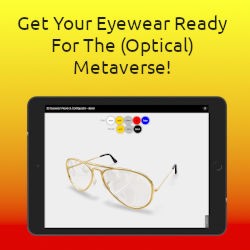Industry News
Eye-tracking Technology Could Help AR
![]() Augmented reality (AR) is poised to have a bright future. Researchers, computer science Ph.D. student Tianxing Li and computer science professor Xia Zhou, at the Dartmouth College in the US have developed battery-free, eye-tracking glasses that could be particularly useful for enhancing existing AR technologies.
Augmented reality (AR) is poised to have a bright future. Researchers, computer science Ph.D. student Tianxing Li and computer science professor Xia Zhou, at the Dartmouth College in the US have developed battery-free, eye-tracking glasses that could be particularly useful for enhancing existing AR technologies.
“The future of AR is bright but the technology is not there yet,” professor Zhou said. “There are still improvements that we need to do in order to make it more realistic and also more energy efficient. The rendering quality of the virtual object, as well as the system optimization of power, are the main two challenges of AR today.”
The eye tracker that the researchers developed can fit into everyday glasses and has the ability to identify the location and size of the pupil. It can be used to optimize rendering for AR glasses, according to Zhou. She added that the technology has medical applications and could be used for “health monitoring” and to “assess the effectiveness of certain clinical treatments.”
According to Zhou, AR users and gamers could benefit from the technology in a myriad of ways, as the technology makes it possible for them to use their eye movements as an “interface to interact with the virtual scene.” With the eye tracker, the users’ eye movements — from blinking to moving the pupil to particular locations — would correspond to certain commands depending on the application.
As an example of the technology’s health applications, Zhou said that the absence of a battery pack makes it possible to “continuously track eye movements” without needing to recharge the system. This could allow the glasses to detect user fatigue after being worn for an extended period of time without charging, for example. Furthermore, Zhou noted that because there are certain correlations between some mental disorders and eye movement characteristics, doctors could use the technology to diagnose those disorders at an early stage.
Zhou said that the project has been developed over the course of the last two years. She added that one of the main problems with current virtual reality systems is their battery-consuming displays, which primarily rely on cameras to render images for the user. Furthermore, the most expensive eye trackers can cost tens of thousands of dollars, according to Zhou.
Because of the high cost of existing eye-trackers, the researchers looked for simpler approaches to developing eye-tracking technology. Li said that they found a solution that utilizes low-cost photodiodes — light sensors — and infrared LEDs to track the eye. Compared to existing eye trackers, the research prototype only cost around US$50.
The pair has continued to work on the project to benefit not just virtual reality systems, but also to solve problems with ambient light interference, which led to the latest prototype of the technology. Li added that instead of a battery pack, solar panels attached to the sides of the glasses could automatically power the system after a sufficient charge.
Li said that after the paper detailing the research was published, he and Zhou were contacted by some start-up companies interested in developing a retail product based on the prototype. Although there is currently no plan to produce a commercial product based on the technology, Li said he viewed this potential development positively.
“If we can make a pretty low-cost eye tracker for everyone, without batteries, most of us can get a benefit from them,” Li said.
At the ACM MobiCon 2018 conference, Li led a brief presentation and question and answer period in which he showcased the glasses. Following the presentation, Li said that at least two companies and a professor from the University of California, Berkeley, asked him to open-source the project.
According to Li, he is able to open-source the project because the technology has already received a patent from the College. Open-sourcing allows Li and Zhou to release both the code currently used by the various components of the technology and the project’s circuit diagram, which will allow other researchers to reproduce and build on their work.
“I think the next step will be to just open-source everything and see what the impact will be,” Li said.
While Dartmouth Mixed Reality Club founder Nathan Yu ’19 said that he was not entirely familiar with the project developed by Li and Zhao, he said he is interested in the product, particularly its eye-tracking capabilities. Yu noted that the new technology can bring various benefits.
“If you’re able to look at the pupils, you can essentially increase the resolution [of what the] person wearing a headset is looking at, so that’s a way to basically make graphics rendering cheaper and present a more realistic experience with the hardware that’s available today,” Yu said.



